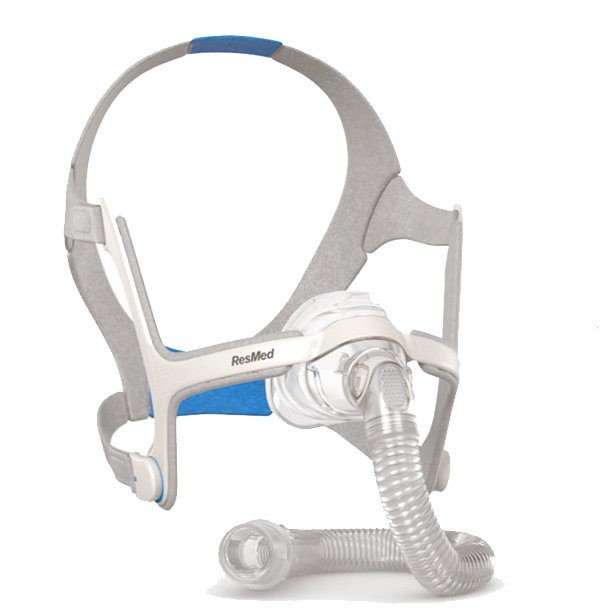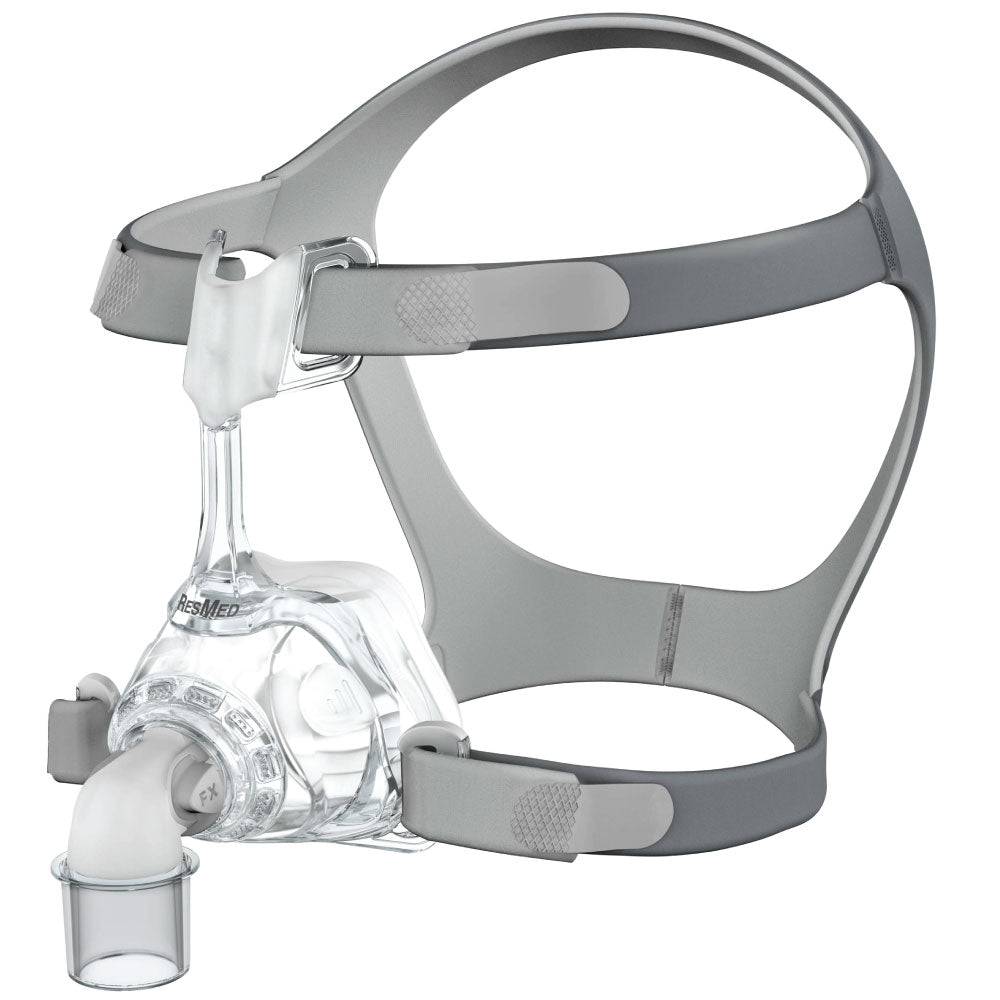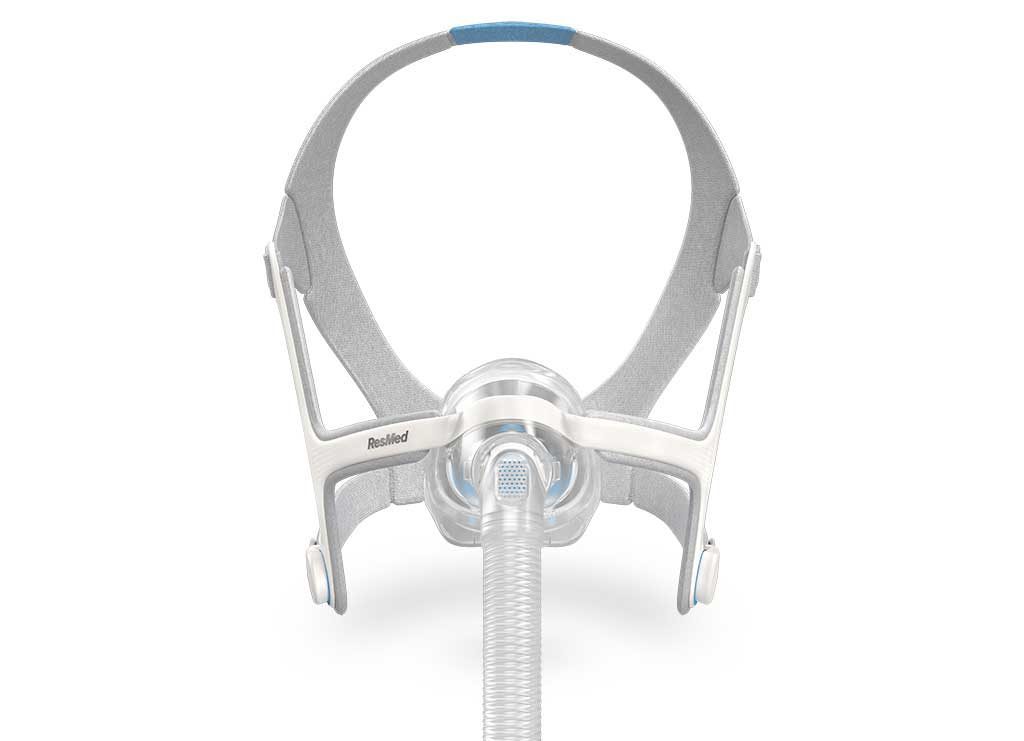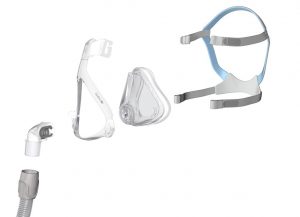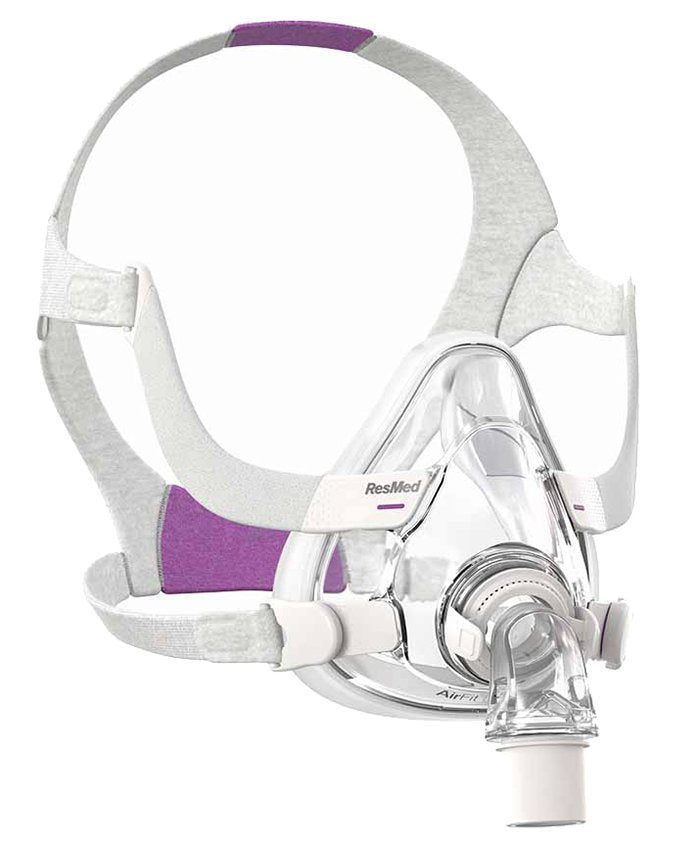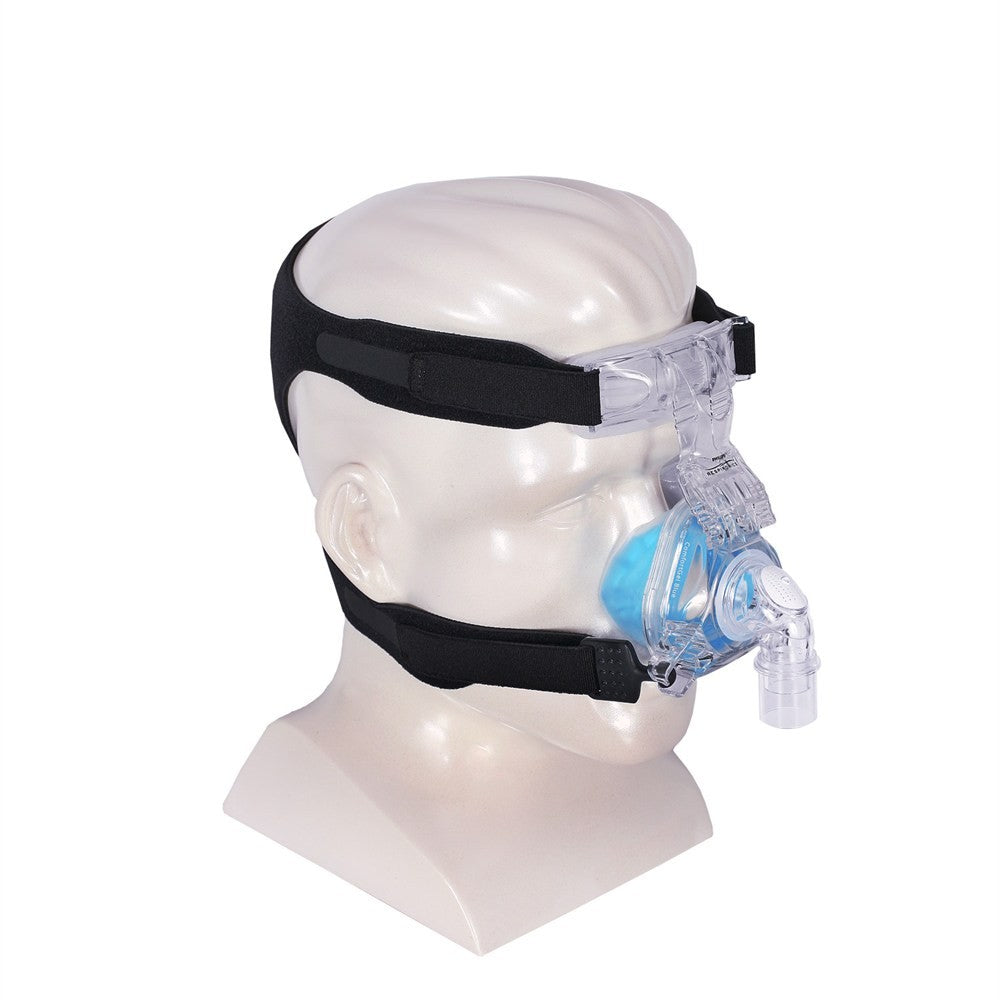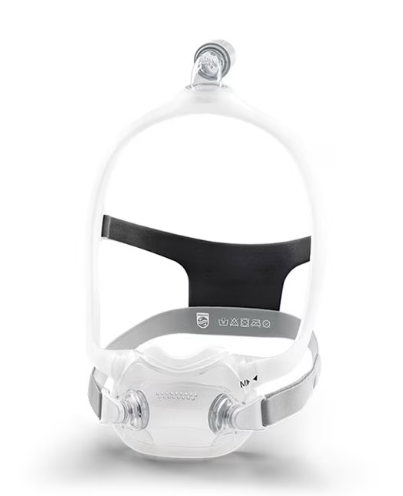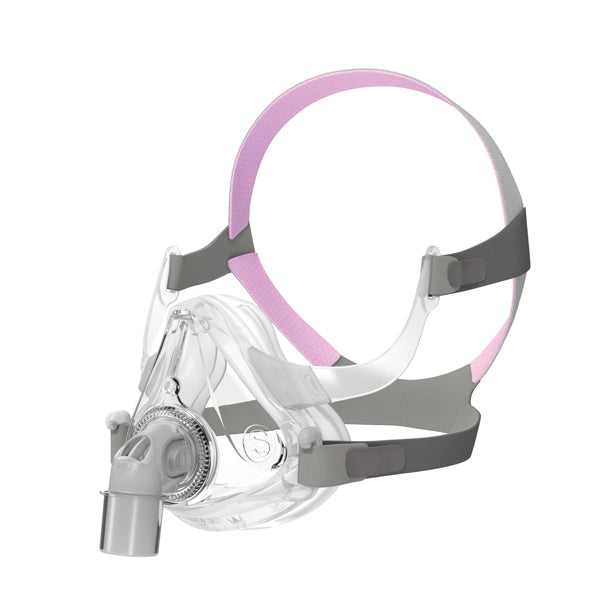Filtres
Questions fréquemment posées
Quels sont les différents types de masques ?
Il existe 3 types courants de masques : les masques faciaux complets, les masques nasaux et les masques nasaux à coussinets. Les types moins courants sont les masques buccaux et les masques faciaux complets.
Masques faciaux complets
Les masques faciaux intégraux couvrent à la fois le nez et la bouche, ce qui les rend idéaux pour les personnes qui respirent naturellement par la bouche ou qui ont des problèmes chroniques de sinus qui rendent la respiration nasale difficile. De plus, ces masques peuvent être plus confortables pour certains utilisateurs, en particulier pour ceux à qui on prescrit une pression plus élevée, car ils répartissent la pression plus uniformément, offrant une expérience plus douce.
Il existe deux types de masques faciaux. Le modèle original a une forme triangulaire, recouvrant l'arête du nez et se situant juste en dessous de la lèvre inférieure. Le ResMed AirFit F20 en est un exemple. Le nouveau modèle, en revanche, ne couvre pas le nez et ne repose pas sur l'arête, mais enveloppe les narines et se ferme juste en dessous de la lèvre inférieure. Le ResMed AirFit F40 en est un exemple.
Masques nasaux
Il existe deux types de masques nasaux pour la thérapie CPAP. Le modèle original, comme le ResMed AirFit N20, couvre tout le nez, se ferme hermétiquement sous les narines et repose sur l'arête, avec un harnais à quatre points pour le maintenir en place. Le nouveau modèle à berceau nasal plus minimaliste, comme le ResMed AirFit N30, ne couvre pas l'arête du nez. Au lieu de cela, il épouse les narines et comporte un harnais plus léger et moins intrusif.
Les masques nasaux sont idéaux pour ceux qui respirent principalement par le nez pendant leur sommeil. Ils constituent également une bonne option pour ceux qui recherchent une alternative plus légère et moins encombrante au masque facial intégral.
Masques à coussin nasal
Les masques à coussinets nasaux font partie des masques CPAP les plus petits et les plus légers disponibles, ce qui en fait un excellent choix pour ceux qui trouvent les masques plus grands encombrants ou qui se sentent claustrophobes. Ces masques sont dotés de coussinets en silicone souple qui se placent sous le nez et sont insérés juste à l'intérieur des narines pour créer un joint étanche à l'air, délivrant de l'air sous pression directement dans le nez. Comme le joint est formé à la base des narines, les masques à coussinets nasaux sont moins susceptibles de laisser échapper de l'air, et leur conception minimaliste offre un maximum de confort et de liberté. Le ResMed AirFit P10 est un exemple de ce type de masque.
Masques buccaux
Conçus pour les personnes qui respirent par la bouche et celles qui souffrent d'une congestion nasale chronique, les masques CPAP buccaux délivrent une pression uniquement par la bouche. Ils conviennent aux personnes qui ne peuvent pas du tout respirer par le nez. Le masque Oracle de Fisher & Paykel est un exemple de ce type de masque.
Masques faciaux complets
Ces masques couvrent l'ensemble du visage, du front au menton, avec un joint périphérique qui minimise les points de pression et les marques rouges. Ils sont idéaux pour les utilisateurs ayant des poils au visage, des irrégularités ou des prothèses dentaires. Le masque facial Respironics FitLife Total Face Mask est un exemple de ce type de masque.
Comment choisir un masque ?
Choisir un nouveau masque peut être difficile, car il s'agit d'un processus très subjectif, et l'ajustement et le confort peuvent varier considérablement d'une personne à l'autre. Cependant, certaines directives peuvent vous aider à faire le bon choix. Par exemple, si vous respirez par la bouche ou si vous souffrez de congestion nasale, un masque facial intégral peut être la meilleure option pour vous. En revanche, si vous avez des poils au visage, un masque facial intégral peut être difficile à ajuster correctement sans fuite, car le joint en silicone a du mal à entrer en contact avec les poils du visage. Dans ce cas, un masque nasal ou un masque à coussin nasal, associé à une mentonnière, peut être plus adapté.
Un autre facteur à prendre en compte est votre position de sommeil. Si vous avez tendance à vous retourner sans cesse, un masque nasal peut être plus adapté, car il offre la meilleure étanchéité pour les dormeurs actifs, en particulier ceux qui dorment sur le côté et sur le ventre.
De plus, la plupart des masques disponibles sur le marché se connectent au tuyau CPAP par l'avant, ce qui peut gêner certains utilisateurs ou les gêner. Certains masques relient le tube par le haut de la tête, ce qui permet au tuyau de pivoter et de rester à l'écart lorsque vous bougez pendant la nuit. Le ResMed AirFit P30i est un exemple de ce type de masque. Nous vous suggérons de vous rendre dans votre magasin CPAP local pour essayer des masques de démonstration, ce qui vous permettra d'évaluer la taille et le confort.
Quelle taille dois-je prendre ?
De nombreux masques CPAP incluent un guide des tailles pour vous aider à choisir la taille qui vous convient. Consultez la page produit pour obtenir un guide des tailles imprimable, si disponible. Certains masques sont livrés sous forme de packs d'ajustement avec plusieurs tailles de coussinets incluses. Étant donné que la taille des masques CPAP varie selon le modèle et la marque, nous vous recommandons de vous rendre dans un magasin CPAP local pour essayer des masques de démonstration afin d'obtenir le meilleur ajustement et le meilleur confort.
Existe-t-il des accessoires de masque qui peuvent contribuer à l’étanchéité et au confort ?
Bien que tous les accessoires pour masque CPAP ne soient pas indispensables, nombre d'entre eux peuvent améliorer le confort et l'efficacité de votre traitement. De plus, certains accessoires permettent aux utilisateurs de bénéficier de types de masques qui ne leur conviendraient pas autrement.
Doublures de masques
Les doublures de masque CPAP sont des pièces de tissu placées entre votre visage et le coussin du masque. Fabriquées à partir de matériaux doux et respirants, elles créent une barrière apaisante qui aide à prévenir les fuites, réduit les irritations et minimise l'accumulation d'humidité à l'intérieur du masque. La doublure de masque RemZzzs en est un exemple. Il est important de noter que les doublures de masque sont spécifiques au style et à la taille et ne sont pas compatibles avec tous les masques. Assurez-vous de consulter la section des doublures de masque sur notre site Web pour voir si une doublure de masque est disponible pour votre masque.
Oreillers CPAP
Les oreillers CPAP sont conçus avec des découpes ou des formes uniques pour accueillir un CPAP
masque pendant que vous dormez. Fabriqués en mousse, ces oreillers sont disponibles dans différents styles pour soutenir différents types de masques et positions de sommeil. Ils offrent un soutien entre votre cou, votre masque et votre appareil CPAP, réduisant ainsi les fuites et améliorant l'efficacité de votre thérapie, aidant ainsi à garder vos voies respiratoires ouvertes pour un meilleur sommeil.
Mentonnières
Les mentonnières CPAP aident les personnes qui respirent par la bouche à utiliser des masques nasaux ou nasaux en gardant la bouche fermée pendant leur sommeil. Disponibles dans différents modèles, la plupart des mentonnières sont réglables et disposent d'une mentonnière confortable. En règle générale, les mentonnières sont portées sous le harnais du masque, bien que certains masques et mentonnières fonctionnent mieux lorsque la mentonnière est portée par-dessus le harnais. Le placement de la mentonnière dépend de la conception du masque, car certains masques ont des tubes dans des zones qui pourraient être bloquées par les sangles d'ancrage de la mentonnière.
À quelle fréquence dois-je nettoyer mon masque et comment ?
Pour nettoyer correctement votre masque CPAP, commencez par le démonter en trois parties : le harnais, le coussin et le cadre. Nettoyez le coussin tous les jours et le harnais et le cadre toutes les semaines. Dans un évier ou un bol, utilisez du savon liquide doux et de l'eau tiède pour laver délicatement chaque partie, en éliminant les huiles. Rincez abondamment à l'eau tiède, puis placez le coussin, le harnais et le cadre sur une serviette posée sur une surface plane pour les faire sécher à l'air libre, ou accrochez le harnais et le cadre sur un crochet ou un cintre. Évitez d'exposer les pièces à la lumière directe du soleil. Vous pouvez également utiliser des lingettes pour masque CPAP pour nettoyer quotidiennement le coussin.
À quelle fréquence dois-je remplacer mon masque ?
Vous trouverez ci-dessous les directives du fabricant. Il est important d'inspecter régulièrement votre masque pour détecter tout signe d'usure et de le remplacer si nécessaire.
- Système de masque complet : tous les 6 à 12 mois
- Coussinets de masque en silicone (masque facial, nasal et coussinets nasaux) : tous les 3 à 6 mois
- Coussins de masque en mousse à mémoire de forme : Tous les mois
Quel masque est compatible avec ma machine ?
Les masques CPAP sont universellement compatibles avec toutes les machines CPAP, quel que soit le fabricant, à l'exception du ResMed AirMini, qui nécessite des options de masque spécifiques. Cela vous permet de choisir n'importe quelle combinaison de masque et de machine en fonction de votre confort et de votre style de vie.
Quels masques sont compatibles avec l'AirMini ?
L'AirMini est compatible avec les masques suivants :
- AirFit N30 pour AirMini (SKU: 38878)
- AirFit P10 pour AirMini (SKU: 38824)
- AirFit F30 (avec connecteur spécial, SKU : 38010)
- AirFit F20/AirTouch F20 (avec connecteur spécial, SKU : 38011)
- AirFit N20/AirTouch N20 (avec connecteur spécial, SKU : 38823)
Puis-je échanger les coussinets entre les masques ResMed AirFit P30i et ResMed AirFit N30i, tout en utilisant le même cadre ?
Oui, les cadres des masques P30i et N30i sont interchangeables, tout comme le coussin
Les verrous sont de la même taille. Cela signifie que vous pouvez passer du coussin nasal P30i au coussin nasal N30i sans avoir besoin d'un cadre différent. Par exemple, si vous possédez un masque nasal AirFit P30i, vous pouvez acheter un coussin N30i pour le transformer en masque nasal. Cette conception offre la possibilité d'essayer les deux styles à l'aide d'un seul cadre.
Puis-je échanger les coussinets entre le masque nasal sous le nez DreamWear et le masque nasal à coussinets DreamWear, tout en utilisant le même cadre ?
Oui, les montures du masque nasal DreamWear sous le nez et des masques nasaux DreamWear sont interchangeables car les attaches des coussins sont de la même taille. Cela vous permet de passer du coussin nasal DreamWear au coussin nasal DreamWear sous le nez sans avoir besoin d'une monture différente. Par exemple, si vous possédez le masque nasal DreamWear, vous pouvez acheter le coussin nasal DreamWear pour le transformer en masque nasal. Cette conception offre la possibilité d'essayer les deux styles en utilisant la même monture.









